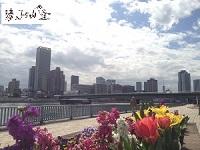Hello, this is Minato kid.
Today, I came to the sidewalks of Nihonbashikabutocho and Kayabacho.
♪ Welcome to the sidewalk museum!
At the foot of the bus stop at Kayabacho 1-chome, I found a picture of Toden.
The Toden in the picture seems to be 19 lines.
It was the route from Dori Sanchome to Oji Station.
In addition, there are many systems that pass through Kayabacho, and it seems that it was a key point of transportation at that time.
It goes back to 1903 that a tram began running in Tokyo.
Time changed, and in the 1940s and 1940s, the transportation network from Toden to subway changed drastically.
There was also a picture of Toden on the sidewalk on the Kabuto-cho side.
I wonder if this is dusk. The sky dyed indigo is beautiful.
Well, let's walk towards Armor Bridge.
I found two pictures of flowers.
In this area, there is a street called Ueki Nagaya.
On the fair, there was a market selling plants and bonsai.
Kabuto-cho and Kayabacho are towns surrounded by three rivers.
Nihonbashi River, Kaede River and Kamejima River.
During the Edo period, there were many unloading sites and warehouses along the river.
In 1872, Eiichi Shibusawa, the father of modern capitalism, set up a residence in Kabuto-cho and founded Daiichi National Bank and Tokyo Stock Exchange.
The five-story tower building that resembles the central keep in the distance is the Daiichi National Bank.
Well, it's the sidewalk in front of the Tokyo Stock Exchange.
It was in 1931 that the cylindrical main building was completed.
A doris-style order column, a statue representing commerce, engineering, agriculture, and transportation, was placed at the top.
In the rear, there was a market hall. The ceiling was a majestic space with a skylight fitted with stained glass in a pale color.
In 1988, it was rebuilt into the current building.
The sidewalk with pictures is interesting, isn't it?
I feel like I can see the expression of the town.
From now on, I would like to walk in Chuo-ku, cherishing the encounter with wonderful sidewalks.
Correspondent Minato kid, Chuo-ku Tourism Association

No. 20 August 19, 2018

 ◀ Tsukuda-ohashi Bridge in Spring
◀ Tsukuda-ohashi Bridge in Spring

